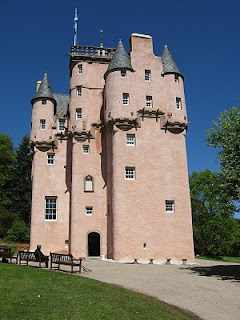Exploring Scotland 1 Castle at a Time, Part 14, Craigievar Castle
We decided to visit Craigivar Castle because our hostess told us how interesting it was and it proved true. The first thing you notice is how PINK the tower house is. The process that produces the color is called harling. The castle itself is created from stone but on the exterior a layer of lime based cement has been adhered to it to weatherproof it. Lime is pourous and allows the stone to breath and the moisture to evaporate so that it doesn't get trapped inside the material and damage the stone. While the surface is still wet, the pigment, which is actually red sandstone, is pressed into the material. Thus, Craigievar attained it's lovely pink color. The red sandstone is even in the gravel of the drive giving it a pinkish cast too.
Another interesting architectural feature of the Castle was the corbelling used to support the weight of the drum towers builting into the structure.
The Castle reminded me of the Disney world castle because of the Cone shaped roofs.
Craigievar was started in 1610 by the Mortimer family but financial problems kept them from finishing the structure. William Forbes, a very rich merchant, bought the Castle and completed it in the 1620's. It remained in his family for 350 years.
It has many of it's original features. An iron yett hangs at the door. A yett was an interwoven gate created with iron strips welded together in such a way that they couldn't be dismantled by anything less than a blow torch. They are indigenous to Scotland. In all the castles we went to, we only saw two, the one at Craigivar and one at Dunvegan Castle on Skye.
In the great hall, they had a screens passage which is like a doorway with a platform built high above it where minstrels would sit and play for the Lord of the castle and his guests. Craigievar is the only castle in Scotland to still have one.
The plaster ceilings date from 1625 and 1626 are similar to the ones at Glamis Castle.
The small windows and doorways of the castle prevented furniture from being moved out of the castle, thus some of the pieces were actually built inside the castle. And some of them have been inspired by changes in needs. Like the bathtub built inside a box bed--a bed framed into the wall like a captains bunk.
We were so lucky to be able to get to tour the castle. It's been closed nearly three years for repairs to the exterior harling. The finishing touches to that were being done while we were there.
The castle originally had a walled enclosure around it with small towers at each corner. This was called a barmkin. The walls weren't as high and the towers attached much smaller than in a larger castle. Cattle would be brought into the enclosure to protect them during raids.
I think Craigievar was interesting because of the untouched quality that it retained. Because of the small doors much of the original furniture and fittings have been inside the castle since it was built so it retains that frozen in time element. That may be true for now but during World War I it was used as a hospital and housed injured Belgian troops.
There were pink crabapples and red maples behind the castle that created a beautiful backdrop to the pink of the castle.
Tomorrow I'll be talking about one of the most unusually constructed Castles in Scotland.
Write on,
Teresa R.









Comments
Thanks again for your wonderful sharing.
Thanks for your comments on Craigievar. It was at one time visited by so many people that they had to shut it down and make repairs. The castle was actually being damaged by the number of feet walking through it.
I appreciate your continuing to follow the blog.
Teresa